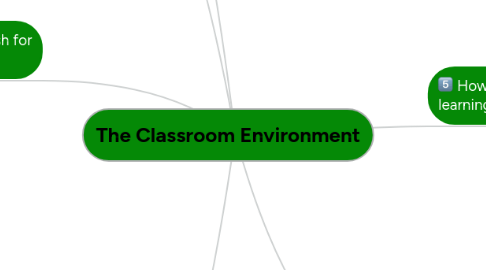
1. How will you create an environment of respect and rapport?
1.1. Modeling respect and courtesy through interactions with students
1.2. Democratic classroom management approach
1.3. Setting clear expectations for interactions between students
1.4. Demonstrating consistency and fairness in acknowledging and interacting with all students
2. How will you establish a culture for learning?
2.1. Maintaining high expectations for all students
2.2. Encouraging participation and effort/persistence
2.3. Demonstrating passion, knowledge, and value of instructional content
3. What procedures will you establish for managing the classroom?
3.1. Carefully planning regular classroom procedures and practicing each early in the school year
3.1.1. transitions within the classroom
3.1.1.1. warnings ahead of transitions
3.1.1.2. "move by the count of 10"
3.1.2. transitions between classrooms
3.1.2.1. lining up
3.1.2.2. clear hallway behavior expectations
3.1.3. recurring lesson activities
3.1.3.1. calling students to attention
3.1.3.2. discussion techniques: Think-Pair-Share/ KWL/ pass around
3.1.3.3. personal space and safety precautions for movement activities
3.1.4. use and maintenance of class supplies
3.1.4.1. routines for distributing and putting away regular supplies
3.1.4.2. safe handling and use of scissors, glue, and other supplies
3.1.4.3. proper maintenance of supplies
3.2. Establishing consistent, predictable daily routines
3.2.1. attendance
3.2.2. setting rotating job roles within the class routines
3.2.3. posting and reviewing schedule
3.2.4. posting and reviewing lesson objectives
4. What procedures will you establish for managing student behavior?
4.1. Having class "agree" on rules of behavior and consequences at the start of the school year
4.1.1. Guiding students toward broad, positively-worded rules
4.1.1.1. class participation in establishing rules promotes understanding and buy-in
4.1.1.2. the 5 universal rules
4.1.1.3. an umbrella over many specific behaviors
4.1.2. Involving students in establishing clear consequences for good and bad behavior
4.1.2.1. setting a procedure of specific consequences
4.1.2.2. providing emotional rather than tangible rewards for good behavior
4.1.2.3. helping students self-monitor behavior by considering the consequences of their choices/actions
4.2. Enforcing rules consistently and fairly to promote a reliable and safe social environment for learning
4.2.1. Focusing on positive feedback for desirable behavior rather than on negative feedback for bad behavior
4.2.1.1. assertive communication
4.2.1.2. redirecting off-task behavior
4.2.1.3. allowing for talk, movement, and interaction that is appropriate and on-task
4.2.2. Addressing situations with students privately
4.2.2.1. private and personal delivery of praise or reprimand that doesn't "put students on the spot"
4.2.2.2. helping individuals monitor their own behavior and meet their needs appropriately
5. How will you organize the students for learning?
5.1. Planning the layout for safety, accessebility, functionality, and efficiency
5.1.1. layout allows for safe and smooth transitions by all students (including special needs students)
5.1.1.1. uncluttered walking lanes
5.1.1.2. centers are planned for specific learning activities (computer center, library, play center, learning rug, etc.)
5.1.2. seating arrangements and learning areas are laid out to allow every student to see, hear, and participate in instruction
5.1.2.1. students can see the white board/projector/etc.
5.1.2.2. motor activities occur in an area with enough space for safe participation
5.1.3. classroom environment is print-rich and includes visual signs to support pre-literate and ELL students
5.1.3.1. includes class library, sight word wall, posted signs, rules, schedules, etc.
5.1.3.2. signage includes visual representations and other languages
5.2. Maintaining organization of materials and overall cleanliness of the classroom
5.2.1. physical resources are organized and accessible to all students
5.2.2. students are taught to properly use and care for resources, as well as how to keep them organized
5.2.3. teacher regularly checks on materials and supplies to ensure they are prepared and ready for use
